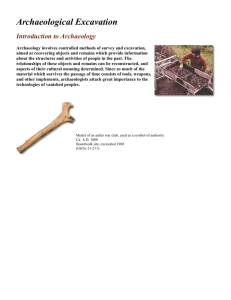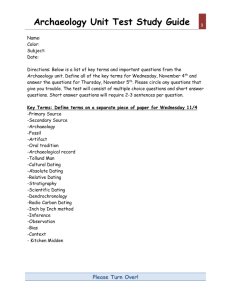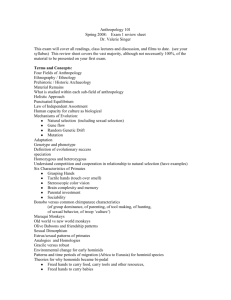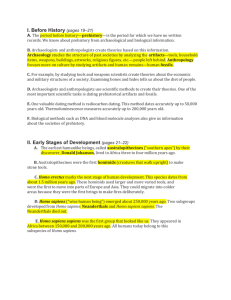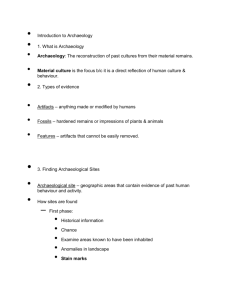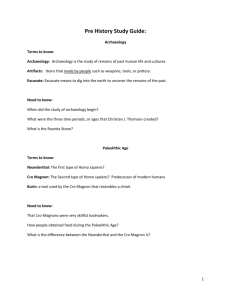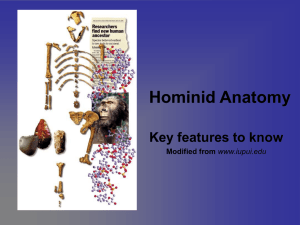Study Guide for Exam 1
advertisement
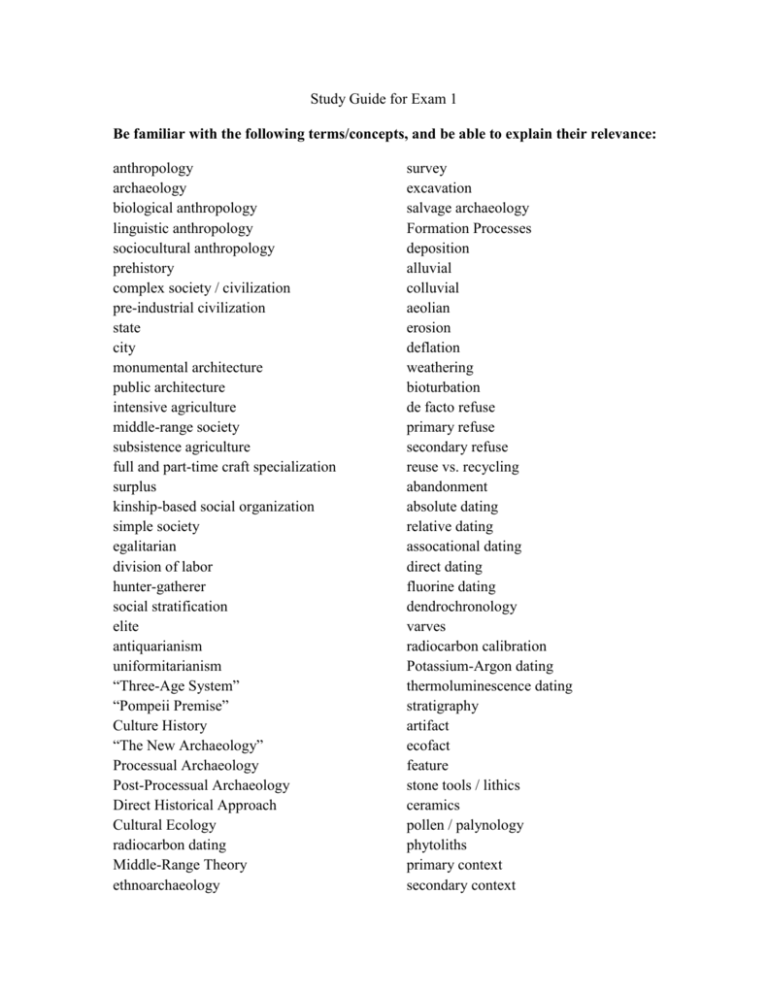
Study Guide for Exam 1 Be familiar with the following terms/concepts, and be able to explain their relevance: anthropology archaeology biological anthropology linguistic anthropology sociocultural anthropology prehistory complex society / civilization pre-industrial civilization state city monumental architecture public architecture intensive agriculture middle-range society subsistence agriculture full and part-time craft specialization surplus kinship-based social organization simple society egalitarian division of labor hunter-gatherer social stratification elite antiquarianism uniformitarianism “Three-Age System” “Pompeii Premise” Culture History “The New Archaeology” Processual Archaeology Post-Processual Archaeology Direct Historical Approach Cultural Ecology radiocarbon dating Middle-Range Theory ethnoarchaeology survey excavation salvage archaeology Formation Processes deposition alluvial colluvial aeolian erosion deflation weathering bioturbation de facto refuse primary refuse secondary refuse reuse vs. recycling abandonment absolute dating relative dating assocational dating direct dating fluorine dating dendrochronology varves radiocarbon calibration Potassium-Argon dating thermoluminescence dating stratigraphy artifact ecofact feature stone tools / lithics ceramics pollen / palynology phytoliths primary context secondary context hominin Lower Paleolithic Pleistocene Holocene island-hopping coastal adaptations Lomekwian Oldowan Acheulean Mousterian Homo sapiens neanderthalensis Middle Paleolithic Upper Paleolithic Mesolithic Paleoindian Archaic (do not confuse with Archaic Homo sapiens) “Venus” figurines bone needles bone and antler harpoons Homo sapiens sapiens Multiregional Evolution Model Recent African Origin Model anatomically vs. behaviorally modern Homo sapiens compound tools personal adornment Clovis Folsom Natufian Be familiar with the following people and their relevance to the history of archaeology: Cyriac of Ancona Thomas Jefferson James Hutton Charles Lyell Jacques Boucher de Perthes Charles Darwin Christian Jurgensen Thomsen Jens J. A. Worsaae Lewis Henry Morgan Edward Tylor Austen Henry Layard Heinrich Schliemann Augustus Henry Lane-Fox Pitt Rivers Franz Boas V. Gordon Childe Julian Steward Gordon Willey Grahame Clark Willard Libby Walter Taylor Be familiar with the following archaeological sites, including their locations, rough ages, and importance: Shanidar Cave Monte Verde Chauvet Cave Blackwater Draw (a.k.a. Clovis) Bobongara Folsom Wareen Cave Koster Lake Mungo Starr Carr Be prepared to answer the following questions in approximately one page: What is the difference or relationship between primary/secondary context and primary/secondary refuse? Give examples. What limitations do archaeologists have to accept in our (re)construction of the past because we do not share cultural context with the people we are studying? What misunderstanding of the nature of the archaeological record led archaeologists to develop the idea of a stone-age “Bear Cult” in parts of Europe? Why did archaeologists of the time think in such a way? What is the real explanation for the data they misunderstood? Describe the two main models of modern human origins of the last 20 years. Why does the recently found evidence of approximately 3% Neanderthal DNA in modern people spell trouble for both models? What alternative model(s) best fit this new evidence? Be able to fill in each blank box in the following chart (on the exam, the majority of the boxes will be filled in for you—the others you will have to fill in yourself): Simple Societies Middle-Range Societies Complex Societies How do they acquire their food? Typical size of an integrated population How is the society structured? What form does leadership take in the society? What kind(s) of settlements does the society have? What kind(s) of structures do they build? Note that “none” may be an appropriate answer in some boxes. It is important to be specific – for example, distinguish between subsistence and intensive agricultuture.


